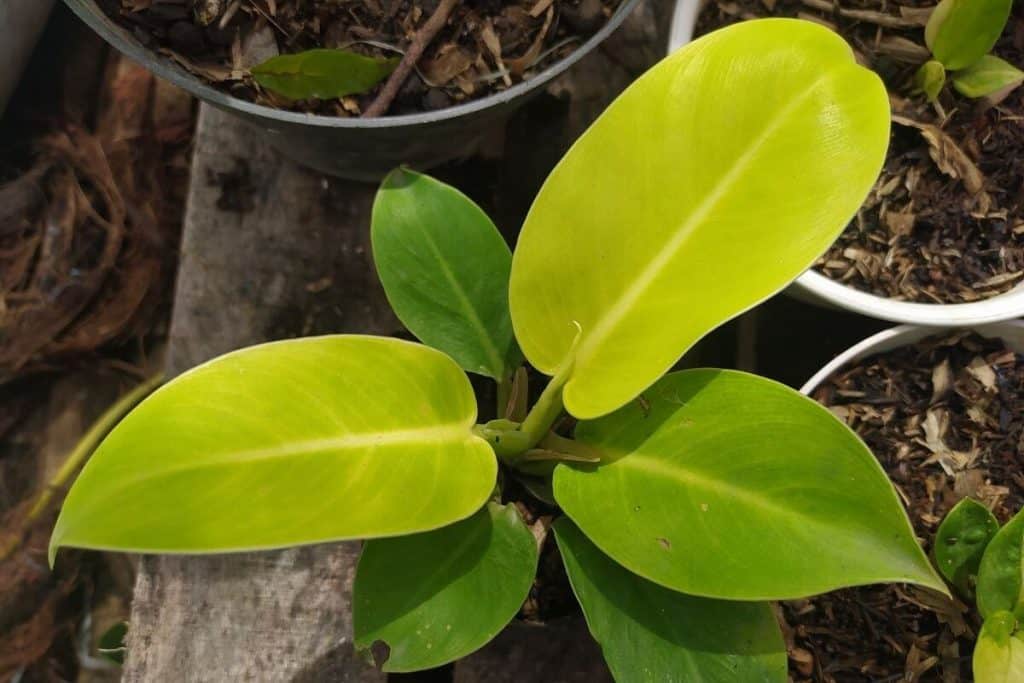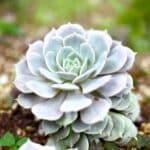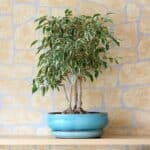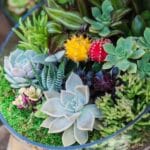Are you thinking of growing a Philodendron plant? By all means, we say go for these beautiful plants. Luckily, there are over 450 philodendron varieties in the world! It follows that you won't run out of philodendron plants that will fit a particular space.
In this post, we are interested in the Philodendron golden goddess care. The Philodendron golden goddess thrives in bright indirect sunlight and should be watered when the topsoil is dry.
Philodendron golden goddess will perform exceedingly well in sandy and fertile soil, with good drainage and some organic matter.
Keep reading to get all the information needed to care for your beautiful Philodendron golden goddess.
Table of Contents
What Is Philodendron Golden Goddess?
Before getting into the care guidelines of this plant, we must familiarize ourselves with some basic information about this plant.
Golden Goddess philodendron is a spectacular climbing houseplant that was created in Thailand as a hybrid plant.
This plant gets the name golden goddess because it has stunning, golden-yellow foliage, which will make a big statement in any home. The Philodendron golden goddess goes with other names like Malay Gold and Lemon Lime Philodendron.
This plant features bold chartreuse foliage. Philodendron golden goddess being a climbing plant (as it is with most philodendrons), can grow up to 6 feet (2m) when placed in a hanging position.
As the name suggests, this plant has dramatic leaves, and it's an eye-catcher! This makes it the perfect choice for desks and tabletops.
The Philodendron golden goddess leaves tend to become larger if grown vertically and in warm, bright conditions making it a good idea for a showpiece plant.
As a climbing plant, this philodendron variety will pair well with other climbing plants like Brasil, pothos, and monstera, making it a versatile and colorful addition to your home or office.
As mentioned earlier, this plant will thrive in bright, indirect light and enjoys warm, humid conditions. You may have to mist the leaves at dry temperature. Golden Goddess performs optimally in temperatures between 65 and 75ºF.
Related Post: Philodendron Thai Sunrise Vs Golden Goddess
Philodendron Golden Goddess Care

Like most Philodendron varieties that are easy to care for, the Philodendron golden goddess is not so different, making them beginner-friendly plants.
Now, let's get into the specifics of some care requirements for the beautiful Philodendron golden goddess.
Philodendron Golden Goddess Water Requirements
The trick to watering your Philodendron golden goddess is to water according to the season. The spring and summer seasons are the growing seasons for the Philodendron golden goddess; it follows that your plant needs good watering in this season.
You may need to tone down your watering frequency in the winter season since the weather is quite humid.
Only water the soil of your Philodendron golden goddess and not the leaves. The leaves enjoy humidity thus should be misted regularly. Water only the top inch soil (about 2.5cm) until it feels slightly damp and not drenched.
If you are a zealous gardener, you might find yourself consistently over-generous with watering. Note that overwatering will cause root rot. This is when the roots of the plant change from standard healthy white to brown or black, becoming quite smelly.
Being climbing plants, the Philodendron golden goddess has aerial roots which may shoot out of the container. If this occurs, gently fix the aerial root into the soil. This will ensure that the plants get adequate moisture.
Philodendron Golden Goddess Light Requirements
Remember that we mention that Philodendron golden goddess thrives under direct bright, indirect light. So, placing this plant under direct sunshine is not a good idea as it can cause sunburned leaves.
Being a high-tolerant plant, the Philodendron golden goddess can actually survive in low light and shadier locations, but the leaves tend to look less green in such circumstances.
To get the best result, place the Philodendron golden goddess in a sunny location with indirect light. This way, the leaves get glossier, and the plant will be a total delight to your eyes.
Soil Requirements
Sand and soil, mixed with moss peat, used to be the traditional mix for Philodendrons, but this mix is no longer seen as environmentally friendly.
For a more environmentally friendly option, replace the moss peat with organic matter like homemade compost, coir, woody materials like wood fiber, sawdust, or composted bark.
Not only are these environmentally friendly options, but they will also add bulk to the soil of your Golden Goddess. This way, you’re rest assured that you're growing your beautiful plant locally and sustainably!
Read Also: How to Care For Philodendron Red Moon
Potting Philodendron Golden Goddess
While the Philodendron golden goddess is a plant that thrives in humidity, too much humidity can hurt the plant. It follows that the Philodendron golden goddess needs a pot that allows excess water to drain away.
The Philodendron golden goddess should be potted in a container or pot with holes to ease drainage. If your plant is sitting on a saucer, ensure you empty the excess water about 30 minutes after you water. You don't the roots of a beautiful plant rotting due to excess moisture.
The Philodendron golden goddess is a large plant, especially when grown under ideal conditions.
You may need to repot every 2-3 years, particularly if you notice the roots sneaking out at the end of the pot or if the current pot is just getting a bit smaller for the plant.
Philodendron Golden Goddess Fertilizer Requirements
While the Philodendron golden goddess can thrive perfectly without fertilizer, you may need to fertilizer this plant once a month in the growing season (that is, spring and summer season).
While fertilizer is necessary to speed up the leaf and stem production, too much of it can cause leaf tip curl and root rot.
Avoid fertilizing the Philodendron golden goddess in the winter season. At this stage, the plant is not in its active growing phase, and any fertilizer applied will remain unused. Also, remember to tone down on watering during the winter season.
Philodendron Golden Goddess Humidity Requirements
As we have mentioned earlier, the Philodendron golden goddess is a humidity-loving plant. This is probably because the plant originated from Thailand, which has average humidity throughout the year.
The Philodendron golden goddess thrives with humidity levels between 25-49%. Thus, in the summer season, you will need to keep the air moist. You may mist the leaves to increase the humidity level or use a humidifier if you don’t have the time to keep on misting the leaves.
Grouping your Philodendron golden goddess with plants with similar humidity requirements is also a great way to raise the humidity levels.
Philodendron Golden Goddess Temperature Requirements
Most Philodendron varieties thrive best in an ideal temperature between 65 – 78°F during the day and around 60°F at night.
The Philodendron golden goddess is no different. You need to maintain a steady warmth at temperatures between 65º and 75ºF for your Philodendron golden goddess.
How to Prune Philodendron Golden Goddess

Remember that we mentioned that the Philodendron golden goddess could be quite a large plant under ideal conditions; it follows that you will undoubtedly need to prune the plant from time to time.
Like most climbing plants, the Philodendron golden goddess tends to appear leggy if not pruned. Pruning helps tidy up the shape, and the stem cuttings can serve as fabulous presents for friends and family, given how rare the Philodendron golden goddess is.
Read Also: How to Care for Philodendron Thai Sunrise
Pests That Affect Philodendron Golden Goddess
Some common pests that might deter the growth of your beautiful Philodendron golden goddess are red spider mites, scale insects, and mealybugs.
1. Spider Mites
Detecting spider mites are very difficult because they’re very subtle. They attack new leaves and buds until nothing is left of the plant. One noticeable sign of spider mites on your Philodendron golden goddess is telltale cobwebs hanging all-around your plant.
The red spider mites secrete these cobwebs and as soon as you spot these webs, spray the leaves with water, then wipe them away with a damp cloth.
2. Scale and mealybugs
These pests multiply so fast before you even notice them. These pests suck moisture from your plant, causing the leaves to discolor. If the infestation is minimal, you can spray the leaves with water, then wipe them away with a damp cloth.
Alternatively, a mixture of dish soap and water can be sprayed on the leaves to eliminate these pests.
Always check your plant weekly in case these pests return. These bugs can only survive in dry conditions, so misting will keep them at bay.
Philodendron Golden Goddess Problems | Diseases That Affects The Plant
There are certain diseases that the Philodendron golden goddess can suffer from, like diseases that cause spots and yellowing of the leaves.
Leaf spot on leaves happens when you water the leaves directly instead of the soil and roots; thus, always aim for the roots with the nozzle of your watering can. Remove any infected leaves and destroy them.
Yellowing of the leaves happens when the plant is deficient in magnesium, especially if the ambient temperature is too cool.
To fix this, treat the plant with a fertilizer of water and Epsom salts and turn up the thermometer to keep your plant cozy. A Magnesium tonic can also be used to fix this deficiency.
Leaf tip curling happens when the soil is too rich from excess fertilizer application. You will need to remove the affected plant and reduce the application of fertilizer.
Root rot occurs when the Philodendron golden goddess is overwatered or too much fertilizer is applied. To treat root rot, uproot the plant and allow the whole plant to dry out.
Then cut off the affected roots with secateurs. Ensure you clean the blade at every cut to avoid spreading disease!
Repot the plant after removing the affected roots and reduce watering and fertilizer application for at least a month.
Propagating Philodendron Golden Goddess
You can easily propagate your Philodendron golden goddess through the stem cutting method.
Gently use a clean knife to cut a stem with leaves attached, then place the cutting in water. In about 2 weeks, roots should develop, and in the third week, pot the cutting in an organic and well-draining potting soil.
The new stem cuttings (about 5 or 6 stems) can be potted in a small container or plastic (this is actually a great way to conserve both moisture and heat).
Place the container or plastic bag in a darkened area like the stairs cupboard. In about a week, the root will start to develop.
In about 3-4 weeks, leaf foliage starts to appear, and at this stage, you can separate each of the stems and give them their own individual pot. Make sure to water the new plant occasionally.
Frequently Asked Questions
How Do You Take Care of a Golden Goddess Philodendron?
As mentioned earlier, Philodendron golden goddess is a beginner-friendly plant, and thus it's quite easy to care for. Below are some tips that will help you care for Philodendron golden goddess:
- Always make sure the plant has the recommended temperature. That is between 65 – 78°F. This is because Philodendron golden goddess is a tropical plant that likes to be snug and moist.
- In hot weather, mist the leaves occasionally and wipe them away.
- Your Philodendron golden goddess should be planted in sandy, well-drained soil.
- Finally, keep this plant out of direct sunlight.
How Often Should I Water My Golden Goddess Philodendron?
Water your Philodendron golden goddess when the topsoil is dry. Or create a watering schedule by watering every 12 days with 0.8 cups of water.
How Do You Propagate Golden Goddess?
The best way to propagate Philodendron golden goddess is through the stem cutting method. Use a sharp knife to cut a stem with leaves attached, then place the cutting in water.
Is Philodendron Golden Goddess Rare?
Yes, the Philodendron golden goddess is a rare variety of Philodendrons. Remember, this plant is a hybrid plant created in Thailand, making it unique and rare.
Read Also: How to Car For Philodendron Birkin




